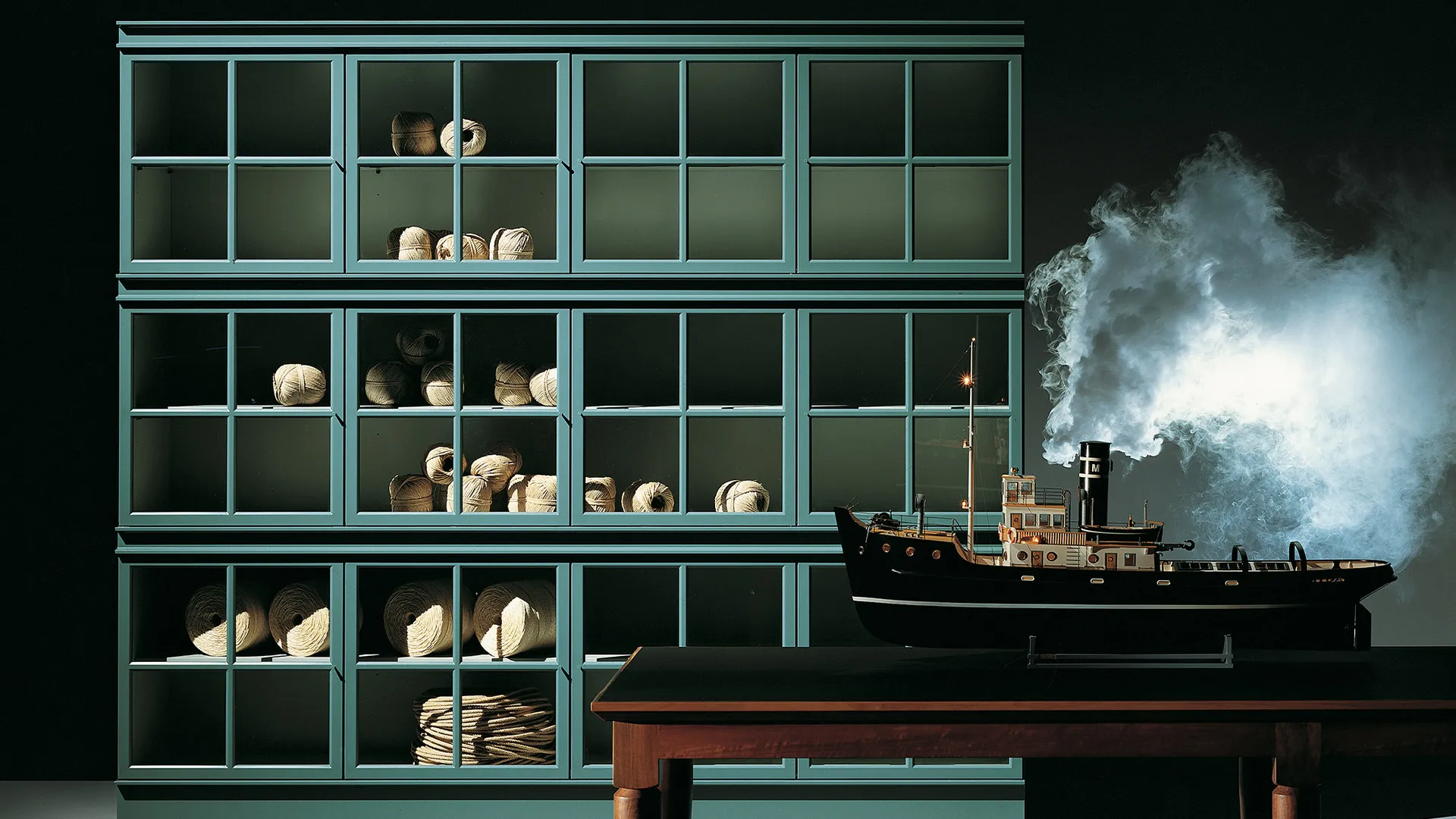The domestic world of Aldo Rossi

Aldo Rossi and Luca Meda, Piroscafo bookshelf, 1992 © Eredi Aldo Rossi, courtesy Molteni&C
Milan is celebrating one of the most important Italian designers and architects of the postwar period, the intensely Milanese Aldo Rossi, who reinvented the domestic landscape by imagining it as a theatrical performance
In Venice, on November 11, 1979, one of the most extraordinarily symbolic works to understand Aldo Rossi’s career and work was inaugurated: the Teatro del Mondo designed as an ephemeral architecture that for a few months changed the panorama of the lagoon before being dismantled. It was in this project, which wedded the themes of the theater, utopia and the transient that Aldo Rossi’s vision is to be found in purity. Now the Museo del Novecento in Milan is devoting an exhibition to it, opened on April 29 (through October 2), entitled Aldo Rossi. Design 1960-1997, conceived as a major retrospective documenting Rossi's commitment during his work as an architect in his personal thinking about objects also in relation to his famous architectural works.

Aldo Rossi, Tea & Coffee Piazza, 1983, Alessi © Eredi Aldo Rossi, courtesy Fondazione Aldo Rossi
The exhibition is curated by Chiara Spangaro, who has devised a layout articulated by over 350 exhibits, including furnishings and practical objects, prototypes and models, paintings, drawings and studies designed and produced by Aldo Rossi from 1960 to 1997, highlighting his constant output as a designer and theorist of architecture. In this respect, Chiara Spangaro recounts the spirit of the exhibition as follows:
“The approach we followed to structure the exhibition design, together with Morris Adjmi (MA Architects, a collaborator and then partner of Rossi in New York, ed) follows Rossi's analogous working method. He always reshuffled the pack in his drawings and architecture, while naturally retaining certain staple points. The exhibition is not an anthology, rather it presents different moments and themes that we have articulated together. Some are themes of logical sense, knowing Rossi, such as the Apollonian figures, domesticity, others are more poetic quotes like the one relating to the San Cataldo cemetery in Modena or the reconstruction of a private domestic space present in one of the rooms starting from the photographs by Ghirri, as well as the personal photos that Rossi’s children have made available to us. The first room is in a way a statement of the exhibition, namely the idea of linking objects to drawing, to architecture, being closely connected in both graphic terms and through the reflection between the large and small scales.”

Aldo Rossi, La cubica pot, 1991, Alessi © Eredi Aldo Rossi, courtesy Fondazione Aldo Rossi
Through Rossi’s important and enduring collaboration with the major Italian furniture companies, visitors will be able to review all the best of that intense creative season that saw names like his working with the finest manufacturers in Italy. From the sixties, working with the architect Leonardo Ferrari, Rossi explored furniture design. However, it was from 1979 on (the same year as the Teatro del Mondo) that the fertile and feverish industrial production and fine craftsmanship began to be produced regularly, with brands such as Alessi, Artemide, DesignTex, Bruno Longoni Atelier d'arredamento, Molteni&C|UniFor, Richard-Ginori, Rosenthal, Up&Up (today UpGroup). Over some twenty years, Aldo Rossi designed more than seventy pieces of furniture and objects, most of which are still in production and exhibited in leading design museums around the world, in every case expressing his sign, which is a synthesis of rationalism, metaphysics and postmodernism. Chiara Spangaro, who is also curator of the Aldo Rossi Foundation, has long been engaged in reconstructing the traces of Rossi's work, which visitors will finally be able to discover even in its lesser-known episodes.
“I started this research about ten years ago, in a period when the foundation was already fully operational, but perhaps there was a less intense workflow. So I went and introduced myself to all the producers and researched the materials, and what emerged compared to the what is more or less common knowledge with respect to Rossi's achievement is that he worked on many other projects, some completely unpublished, never exhibited, some never produced. Many, for example, were shelved and never put into production for commercial reasons or from various other causes. This has enabled us to work on a universe that is actually much richer than that commonly associated with Rossi.”

Aldo Rossi, Papyro desk, 1990 Molteni&C. © Eredi Aldo Rossi, courtesy Fondazione Aldo Rossi
Coffee pots that are actually towers with their domes, bookcases that could be elevations of rationalist and metaphysical buildings, carpets like city plans and palaces never built. And then the color; that characterizes his beautiful drawings and paintings and becomes a structural element when its covers the three-dimensional volumes of his architecture as well as his objects. One might think that the functionality of design was not at the center of Rossi’s priorities as a designer, although as we have seen, many of his objects continue to be produced and used while others with time have become pure works of art, sought after by collectors.
“Many objects have gone out of production,” explains Chiara Spangaro. “Every object has its own history. There are projects, for instance, that grew out of his collaboration with Luca Meda, when Meda was art director of Molteni&C. There are photos of stylistic features that are part of the Rossi vocabulary, such as the square window with the cross frame, or the orthogonal form of some chairs. Then there are others that diverge from this codification and come from different worlds, for example that of Rossi's memory and direct experience, such as the marble table for Up&Up that was remodeled starting from a wooden table in his office, a very classic nineteenth-century piece of furniture at which Rossi worked, and which he simply wanted to reproduce in marble. There is another example of a similar appropriation and reinvention, the sideboard-vitrine for Bruno Longoni. In the exhibition this can be seen in the forms of the wardrobe exhibited in the reconstruction of the domestic space that Rossi had at home, and which displays very similar details.”

Aldo Rossi with the Parigi armchair for UniFor, 1989 © Federico Brunetti
Art and life, design as idea and representation alternate vividly in the exhibition. “Our aim was precisely to mix architecture, design, personal objects and paintings, to recreate a total world of Aldo Rossi and not just user objects tout court,” says the curator, who also approached the exhibition as a space of study and insights, a way to immerse oneself in Rossi’s design process, which led to the conception of his most iconic pieces.
“There are sources that are profoundly characteristic of Rossi, yet differing profoundly in the origin of some of his objects. I am thinking, for example, of the Cabin of Elba, which grew out of archetypal suggestions, from childhood, so to speak, connected with his studies of wooden houses, the theater of the world and lighthouses, and it belongs to a strand of research into a magical/playful imagery that Rossi often presents in his drawings as in his architecture. Then the Parigi chair and the Cartesio bookcase for Uniform, for instance, can be understood as attempts by Rossi to experiment outside the productions of high craftsmanship using noble materials such as wood, ceramics or marble. Instead he was exploring a more industrial approach with materials such as metal or the polyurethane foam he used in the Parigi chair.”
This great work of collecting exemplars and documents has been made possible through collaboration with various museums and corporate archives (Museo Alessi; Molteni Museum; the archives of Bruno Longoni Atelier d'arredamento and Up Group); Italian and international museum collections (Bonnefanten Museum, Maastricht; Centre Georges Pompidou, Paris; Fondazione Museo Archivio Richard-Ginori della Manifattura di Doccia, Florence; MAXXI - Museo delle arti del XXI secolo, Rome; Università IUAV in Venice; Triennale di Milano), as well as various private loans. Together with the exhibition, the catalogue raisonné Aldo Rossi. Design 1960-1997 has been published by Silvana Editoriale, edited by Chiara Spangaro herself and accompanied by a critical essay by Domitilla Dardi. For its duration, the exhibition will be enriched with a program of supplementary events, an unmissable opportunity to explore the continent of Aldo Rossi’s achievement.
ALDO ROSSI. DESIGN 1960-1997
curated by Chiara Spangaro
April 29 - November 6, 2022
Museo del Novecento, Milan

















